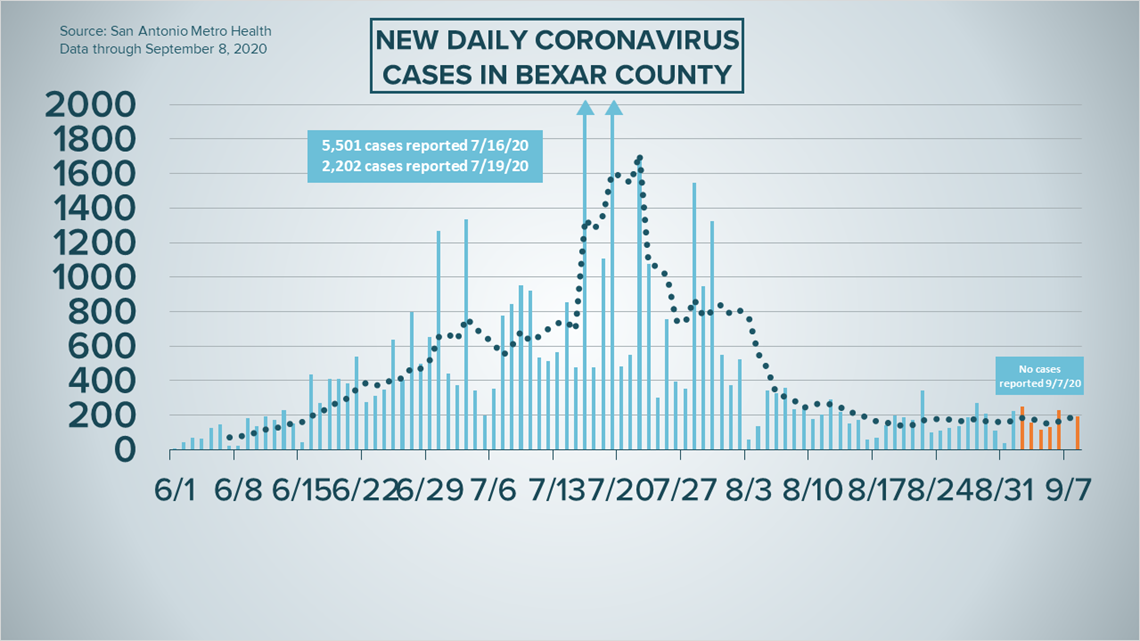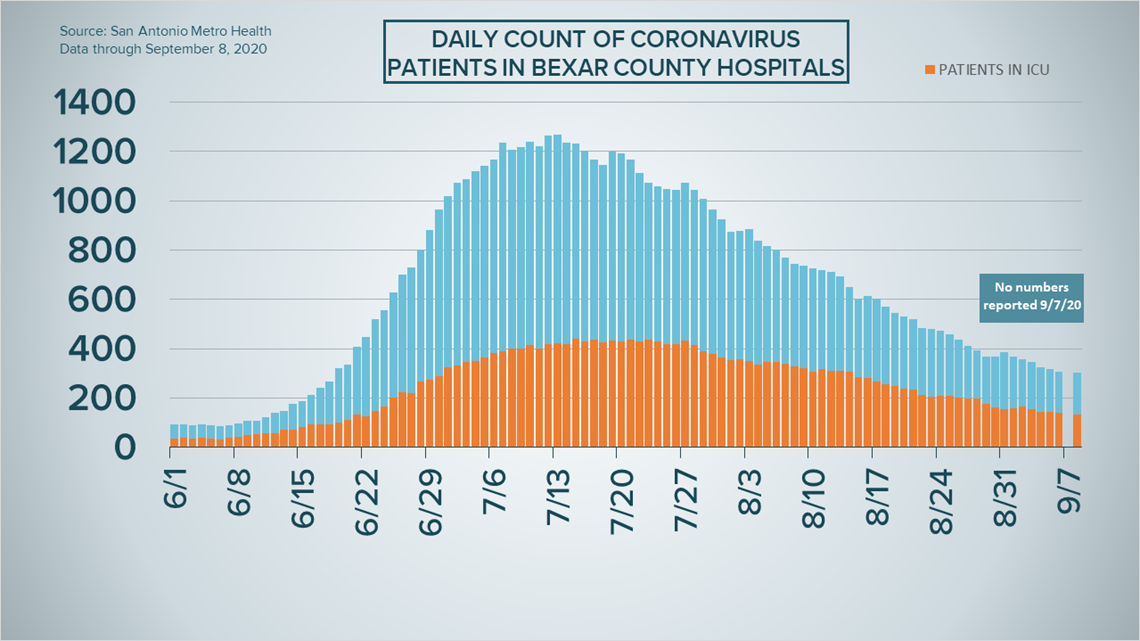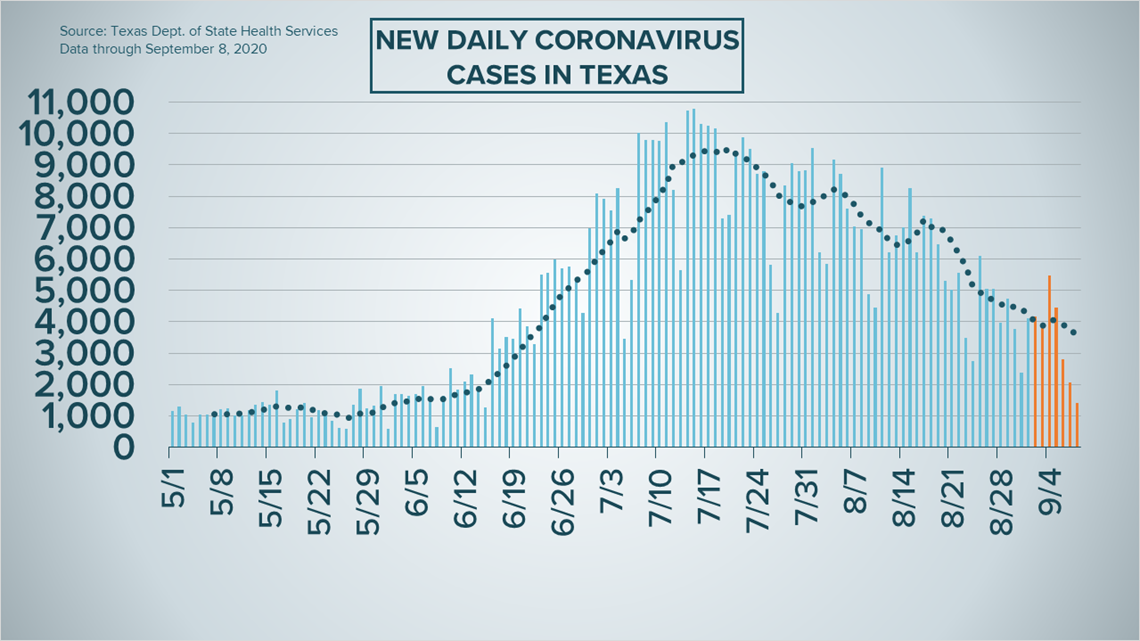SAN ANTONIO — We're tracking the latest numbers from the coronavirus pandemic in San Antonio and across Texas. Here are the latest numbers reported by Bexar and surrounding counties:
- Bexar County: 193 new cases were reported Tuesday, bringing the total number for the county to 47,736. The county death toll, meanwhile, rose to 979 after one new fatality was reported.
- Comal County: The county reported 21 additional cases and no additional deaths Friday, the last time new numbers were offered. There have been a total of 3,071 cases of COVID-19 in the county – including 2,440 confirmed cases – while 111 county residents have died. County officials say there are 288 active coronavirus cases, and 2,672 residents are considered recovered.
- Hays County: Officials in Hays County on Tuesday reported 55 new cases in the county and one additional virus-related death since September 4. As of Tuesday, there are a total of 5,526 lab-confirmed cases in the county (1,988 of which are active) while the death toll stands at 51. 3,487 are considered recovered.
How Bexar County is trending
We've tracked how many coronavirus cases have been confirmed in Bexar County from the time officials began reporting cases in March 2020. The graphic below shows the number of cases since June and charts those daily case numbers along a 7-day moving average to provide a more accurate picture of the overall coronavirus case curve in our area and the direction we're trending amid the pandemic.
On Tuesday, Mayor Ron Nirenberg said that the risk level in the county had lowered into the safe-to-moderate range after weeks of progress.
He reported 193 new coronavirus cases in Bexar County. That brings the total to 47,736 since the pandemic began.


He also reported one new virus-related death on Tuesday, bringing the total to 979.
Hospitalizations continue to drop for the county. On Tuesday, Bexar County reported 304 hospitalized for COVID-19. The number of patients in intensive care (134) fell slightly and the number of patients using ventilators (81) fell by two.


Nirenberg said that the county had reached a sustained two week decline, which is a good sign, but he stressed that the pandemic is not over and people must remain vigilant.
The positivity rate is down again to 6.7%, moving toward the goal of 5%. The number of days it takes to double the number of cases in the community is now 65.
Nirenberg said that because of the sustained progress in several key areas, the risk level in the county has moved into the "safe-to-moderate" range. He said that this can be attributed in part to social distancing efforts, masks, and other efforts, and asked citizens to continue taking these precautions.
"The word 'safe' is not an excuse to let the past few months of hard work go to waste," he said. "We saw that happen earlier in the summer."
He said that the students and teachers returning to class today are counting on everyone in the community to wear masks and stay safe.
Bexar County Judge Nelson Wolff noted that it will have to wait a few weeks to see if the return to school and Labor Day weekend lead to a spike in cases.
Coronavirus in Texas
The Texas Department of State Health Services on Tuesday reported an additional 1,416 cases of the novel coronavirus across the state, the lowest single-day increase since June 15. State officials say five "older cases" were included in the statewide total but excluded from its new confirmed case totals. More information can be found at the top of this page.
As of Tuesday, at least 641,791 Texans have been infected with COVID-19.


Meanwhile, the state also reported an additional 61 coronavirus-related deaths on Tuesday, raising the death toll to 13,553.
553,409 Texans have recovered from the coronavirus, while an estimated 74,829 cases remain active.
The number of patients currently in Texas hospitals jumped a bit to 3,701 on Tuesday.
On Monday, Governor Greg Abbott extended the disaster declaration for all Texas counties in response to coronavirus. The proclamation was first issued on March 13.
"I urge Texans to take precautionary steps to protect their health by wearing a mask, social distancing, and sanitizing their hands. Working together, we will slow the spread and keep our communities safe," said Gov. Abbott.
As the school year begins to get underway for local districts, we are also keeping track of the most important updates for each, including links to dashboards created to track coronavirus cases.
Latest Coronavirus Headlines
- 'Nothing we can do except wait and see': Landlord leaves properties vacant to avoid more debt during eviction moratorium
- Stimulus letter coming to 9 million Americans who haven't gotten paid
- Students return in person at some of SA's largest districts
- Here's how colleges put small towns at greater risk for COVID-19
- Companies testing coronavirus vaccines pledge safety, high standards
- Senate to vote on GOP's 'targeted' virus aid package; doesn't include second stimulus check
- Statewide COVID-19 disaster declaration extended by Gov. Greg Abbott
- Hopes fading for coronavirus deal as Congress returns
Coronavirus symptoms
The symptoms of coronavirus can be similar to the flu or a bad cold. Symptoms include fever or chills, cough, shortness of breath or difficulty breathing, fatigue, muscle or body aches, headache, new loss of taste or smell sore throat, congestion or runny nose, nausea or vomiting and diarrhea, according to the Centers for Disease Control.
Most healthy people will have mild symptoms. A study of more than 72,000 patients by the Centers for Disease Control in China showed 80 percent of the cases there were mild.
But infections can cause pneumonia, severe acute respiratory syndrome, kidney failure, and even death, according to the World Health Organization. Older people with underlying health conditions are most at risk.
On June 25, the CDC expanded the list of groups at a higher risk of severe illness due to coronavirus.
Experts determined there was consistent evidence these conditions increase a person's risk, regardless of age:
- Chronic kidney disease
- COPD (chronic obstructive pulmonary disease)
- Obesity (BMI of 30 or higher)
- Immunocompromised state (weakened immune system) from solid organ transplant
- Serious heart conditions, such as heart failure, coronary artery disease, or cardiomyopathies
- Sickle cell disease
- Type 2 diabetes
The CDC believes symptoms may appear anywhere from two to 14 days after being exposed.
Human coronaviruses are usually spread...
- Between people who are in close contact with one another (within about 6 feet).
- Through respiratory droplets produced when an infected person coughs, sneezes or talks. These droplets can land in the mouths or noses of people who are nearby or possibly be inhaled into the lungs.
- Some recent studies have suggested that COVID-19 may be spread by people who are not showing symptoms.
Help stop the spread of coronavirus
- Stay home when you are sick.
- Eat and sleep separately from your family members
- Use different utensils and dishes
- Cover your cough or sneeze with your arm, not your hand.
- If you use a tissue, throw it in the trash.

